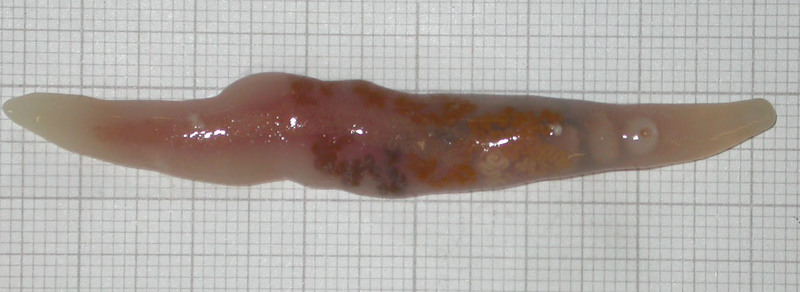Trematode (Class: Trematoda) - Wiki Trematoda
From Wikipedia, the free encyclopedia
[Photo] Botulus microporus, a giant digenean parasite from the intestine of a lancetfish. Photo by http://en.wikipedia.org/wiki/User:Anilocra and released to the public domain
The Trematoda is a class within the phylum Platyhelminthes that contains two groups of parasitic worms, commonly referred to as flukes.
Taxonomy and biodiversity
The Trematoda are estimated to include 18 000 to 24 000 species, and are divided into two subclasses. Nearly all trematodes are parasites of molluscs and vertebrates. The smaller Aspidogastrea, comprising about 100 species, are obligate parasites of molluscs and may also infect turtles and fishes, including cartilaginous fishes. The Digenea, which constitute the majority of trematode diversity, are obligate parasites of both molluscs and vertebrates, but do not occur in cartilaginous fishes. Crepidostomum sp. do occur in Lake Sturgeon.
Formerly the Monogenea were included in the Trematoda on the basis that these worms are also vermiform parasites, but modern phylogenetic studies have raised this group to the status of a sister class within the Platyhelminthes, along with the Cestoda.
Etymology
Trematodes are commonly referred to as flukes. This term can be traced back to the Saxon name for flounder, and refers to the flattened, rhomboidal shape of the worms.
The flukes can be classified into two groups, on the basis of the system which they infect in the vertebrate host. Tissue flukes infect the bile ducts, lungs, or other biological tissues. This group includes the lung fluke, Paragonimus westermani, and the liver flukes, Clonorchis sinensis and Fasciola hepatica. Blood flukes inhabit the blood in some stages of their life cycle. Blood flukes include species of the genus Schistosoma.
Life cycles
All trematodes infect molluscs and most have a complex life cycle involving other hosts. Most trematodes are monoecious and alternately reproduce sexually and asexually. The two main exceptions to this are the Aspidogastrea, which have no asexual reproduction, and the schistosomes, which are dioecious.
In the definitive host, in which sexual reproduction occurs, eggs are commonly shed along with host feces. Eggs shed in water release free-swimming larval forms that are infective to the intermediate host, in which asexual reproduction occurs.
http://en.wikipedia.org/wiki/Trematoda
| The text in this page is based on the copyrighted Wikipedia article shown in above URL. It is used under the GNU Free Documentation License. You may redistribute it, verbatim or modified, providing that you comply with the terms of the GFDL. |
